冀教版九年级英语全一册 Unit 3 单元 教案
冀教版英语九年级全一册 Unit 3:Lesson 13 Be Careful,Danny!. 教案

Show some pictures to present the new words and the new phrases: Let students write them down Say them and remember them.
过一个病人。
3.Help!救命!Help 在这里用作感叹词,是呼救用语,意
Finish the
思是“救命”。例如:A poisonous snake is after me.Help! exercise on the
一条毒蛇在追我,救命呀!
board,then
4.I tried to catch you,but you landed on top of me.我试图接 check the
1. I can write as ____ as you (careful)
2. He is very _____so he does everything very well.
(carefully)
3. He looks like a ______man. (serious)
4. His grandpa is ______ill.(serious) 5.He____(躺)on the bed when I come in. 6.He often_____(撒谎).Don’t believe him
学法:学生中心教学法
By using the words and phrases in
教师教学活动设计
学生学习活动设计 环节调整及修改
一 、 学 习 目 标 .safety, lie, careful, serious, decorate, hang ,necessary , ceiling , ambulance jump up ,on top of , be concerned about , hear sb. do sth. 二、自学提纲: 1:Read out new words:Tidy sofa vacation scare doorbell scream Zoe gentle loyal 2.Try to translate the text into Chinese and find out hard sentences.
冀教版英语九年级全一册 Unit 3:Lesson 13 Be Careful,Danny!. 教案
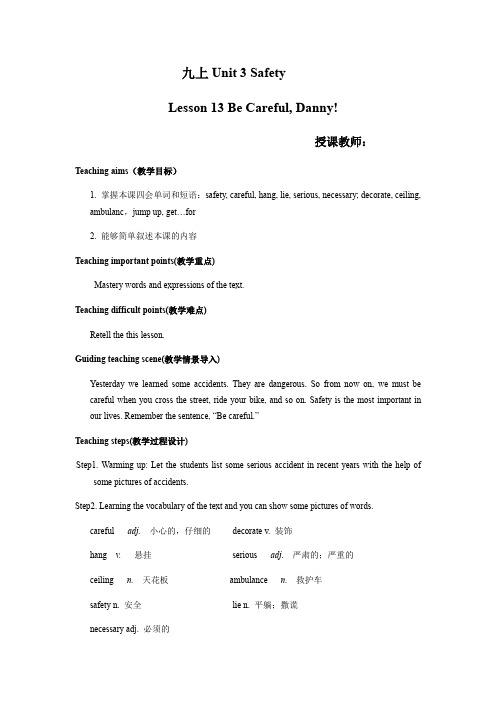
九上Unit 3 SafetyLesson 13 Be Careful, Danny!授课教师:Teaching aims(教学目标)1. 掌握本课四会单词和短语:safety, careful, hang, lie, serious, necessary; decorate, ceiling,ambulanc,jump up, get…for2. 能够简单叙述本课的内容Teaching important points(教学重点)Mastery words and expressions of the text.Teaching difficult points(教学难点)Retell the this lesson.Guiding teaching scene(教学情景导入)Yesterday we learned some accidents. They are dangerous. So from now on, we must be careful when you cross the street, ride your bike, and so on. Safety is the most important in our lives. Remember the sentence, “Be careful.”Teaching steps(教学过程设计)Step1. Warming up: Let the students list some serious accident in recent years with the help of some pictures of accidents.Step2. Learning the vocabulary of the text and you can show some pictures of words.careful adj.小心的,仔细的decorate v. 装饰hang v. 悬挂serious adj.严肃的;严重的ceiling n.天花板ambulance n.救护车safety n. 安全lie n. 平躺;撒谎necessary adj. 必须的Step3. Listening task: Listen to the tape twice with the following questions and then answer them.1. What are Danny, Jenny and Brian doing?2. Does Mr. Jones come here?Keys: 1.They are decorating the art classroom for Christmas. 2. Yes, he does.Step4. Reading task: Read the text carefully with these questions and then give the keys to them.1. What’s the matter with Danny?2. Where is Brian?3. Where do they send Brian?Keys: 1.Danny falls off the chair.2. He is under Danny.3. They send him to the hospital.Step5. Explain the text and remember the language notes.1. List some serious accidents in recent years. 列出几例近几年的严重的交通事故。
冀教版九年级全一册英语教案:Unit3Lesson18
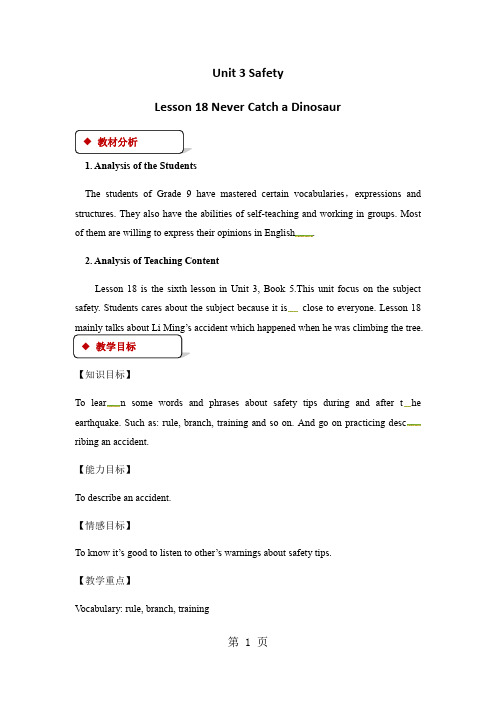
Unit 3 SafetyLesson 18 Never Catch a Dinosaur1. Analysis of the StudentsThe students of Grade 9 have mastered certain vocabularies,expressions and structures. They also have the abilities of self-teaching and working in groups. Most of them are willing to express their opinions in English.2. Analysis of Teaching ContentLesson 18 is the sixth lesson in Unit 3, Book 5.This unit focus on the subject safety. Students cares about the subject because it is close to everyone. Lesson 18◆教学目标【知识目标】To lear n some words and phrases about safety tips during and after t he earthquake. Such as: rule, branch, training and so on. And go on practicing desc ribing an accident.【能力目标】To describe an accident.【情感目标】To know it’s good to listen to other’s warnings about safety tips.【教学重点】V ocabulary: rule, branch, training【教学难点】To describe an accident...Tape recorder, MultimediaStep 1. Warm-upFree talk:1. Show the picture of two boys climb the tree, ask students: What happened? What are the two boys doing? If you fall down from a high place, what would happen?What would you do if you see someone falling down?Step 2. Presentation1.Explain the new words: branch, rule, training.2.Listen to the lesson and write true (T) or fa lse (F).(1)Danny felt terrible because of his carelessness. ( )(2)Li Ming broke his leg at the age of seven. ( )(3)Li Ming tried to climb a ladder, but he fell down. ( )(4)Li Ming’s mother caught him and saved him. ( )(5)It took Li Ming about 90 days to recover. ( )3.Check the answers.4.Explain the language points:I will never try to catch a falling dinosaur.catch a falling dinosaur意为“接住一只往下掉的恐龙”,指去做超过自身能力的事情。
冀教衔接版九年级英语全一册Unit Three教案
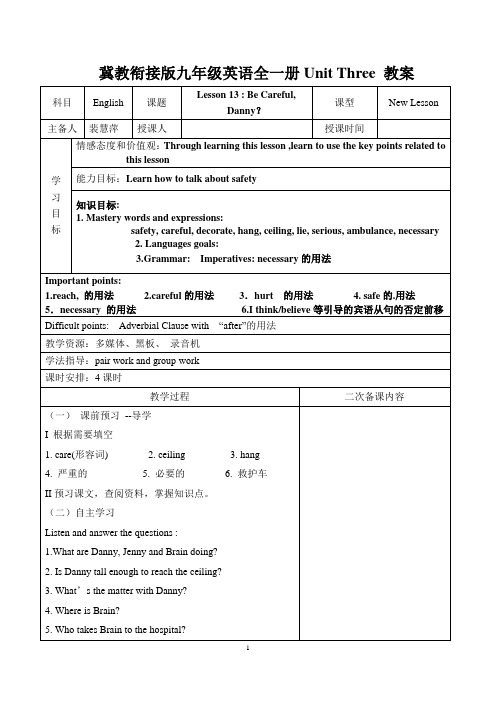
1.Be careful,Danny!
2.Wasitsafe?
3.My tailhurts a little, but it’s not serious.
4.That’s notnecessary.
Necessary,常用于It’s necessaryfor sb. to do sth.
能力目标:Mastery words and expressions.
知识目标:
1.Mastery words and expressions: sudden, blood, knee, rock, stick, stranger, careless, helmet, wham, bleed, sharp, scary, goodness
冀教衔接版九年级英语全一册Unit Three教案
科目
English
课题
Lesson 13 : Be Careful, Danny?
课型
New Lesson
主备人
裴慧萍
授课人
授课时间
学习目标
情感态度和价值观:Through learning this lesson ,learn to use the key points related to this lesson
6. Thank goodness I wore my helm子,每空一词。
1.在你骑车的时候要小心。
Don’t be __________ when you ride your bike.
3.他太小了,不能去上学。
He is _______ young _________ he can’t go to school.
4. And the street was icy---the car couldn’t stop in time.
冀教版英语九年级全一册Unit3:Lesson13BeCareful,Danny教学设计

在本章节的教学过程中,教师将采用以下方法引导学生学习:
1.情境教学法:通过创设生活情境,让学生在实际语境中学习和运用安全知识,提高学生的实践能力。
2.任务型教学法:教师设计各种与安全相关的任务,引导学生分组合作,培养学生团队协作能力和解决问题的能力。
3.互动式教学法:教师引导学生进行课堂讨论,让学生在交流中掌握安全知识,提高学生的思维品质。
(二)讲授新知(500字)
1.教师带领学生学习本节课的词汇,如"careful", "danger", "hurt", "accident", "prevent"等,通过图片、实物展示等方法,帮助学生理解和记忆词汇。
2.讲解一般现在时态在描述安全规则时的运用,通过实例分析,让学生掌握该时态的结构和用法。
3.社会责任感:学生能够关注社会安全问题,关心他人的生命健康,积极参与安全教育活动,提高社会责任感。
4.爱国情怀:通过对安全知识的学习,学生能够认识到我国在安全领域取得的成就,增强民族自豪感,激发爱国情怀。
5.生命教育:通过本章节的学习,学生能够珍惜生命,关爱他人,树立正确的人生观和价值观。
二、学情分析
四、教学内容与过程
(一)导入新课(500字)
1.教师通过多媒体展示一组关于日常生活中的安全警示标志,引导学生关注这些标志的含义和作用。
2.邀请学生分享他们在生活中遇到的安全事故或安全提示,让学生认识到安全的重要性。
3.由此导入新课,告诉学生本节课我们将学习与安全相关的英语知识,以便在生活中学以致用,提高安全意识。
4.布置课后作业,要求学生结合所学内容,撰写一篇关于安全注意事项的英语短文,巩固课堂所学知识。
Unit3 Be careful, danny! 教案冀教版英语九年级全册
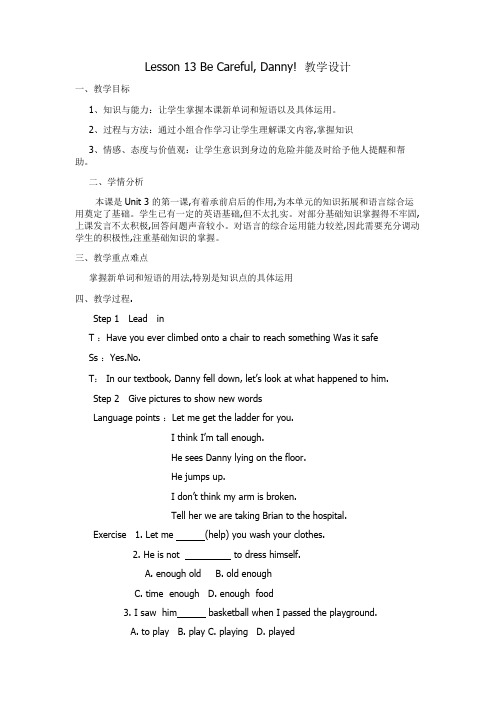
Lesson 13 Be Careful, Danny! 教学设计一、教学目标1、知识与能力:让学生掌握本课新单词和短语以及具体运用。
2、过程与方法:通过小组合作学习让学生理解课文内容,掌握知识3、情感、态度与价值观:让学生意识到身边的危险并能及时给予他人提醒和帮助。
二、学情分析本课是Unit 3 的第一课,有着承前启后的作用,为本单元的知识拓展和语言综合运用奠定了基础。
学生已有一定的英语基础,但不太扎实。
对部分基础知识掌握得不牢固,上课发言不太积极,回答问题声音较小。
对语言的综合运用能力较差,因此需要充分调动学生的积极性,注重基础知识的掌握。
三、教学重点难点掌握新单词和短语的用法,特别是知识点的具体运用四、教学过程.Step 1Lead inT :Have you ever climbed onto a chair to reach something Was it safeSs :Yes.No.T:In our textbook, Danny fell down, let’s look at what happened to him.Step 2Give pictures to show new wordsLanguage points :Let me get the ladder for you.I think I’m tall enough.He sees Danny lying on the floor.He jumps up.I don’t think my arm is broken.Tell her we are taking Brian to the hospital.Exercise 1. Let me (help) you wash your clothes.2. He is not to dress himself.A. enough oldB. old enoughC. time enoughD. enough food3. I saw him basketball when I passed the playground.A. to playB. playC. playingD. played4. I know you tomorrow.A. are arrivingB. is arrivingC. arrivedD. arrive5. I think he is right.(变为否定句)6. Be !(care)Step 3Read and answerRead and answe questions1.What were Danny ,Jenny and Brian doing2. What did Danny climb onto3.Did Brian need an ambulance4.Who is Jenny going to call分成四组,一组回答一个问题Step 4 Read again and fill in the blanksStep 5 Work in groups of five. One of you can be the narrator. The others can be Danny, Brian, Mr. Jones and Jenny.Step 6 summaryStep 7 Safety in the classroom。
冀教版英语九年级全一册Unit3:Lesson13BeCareful,Danny!.说课
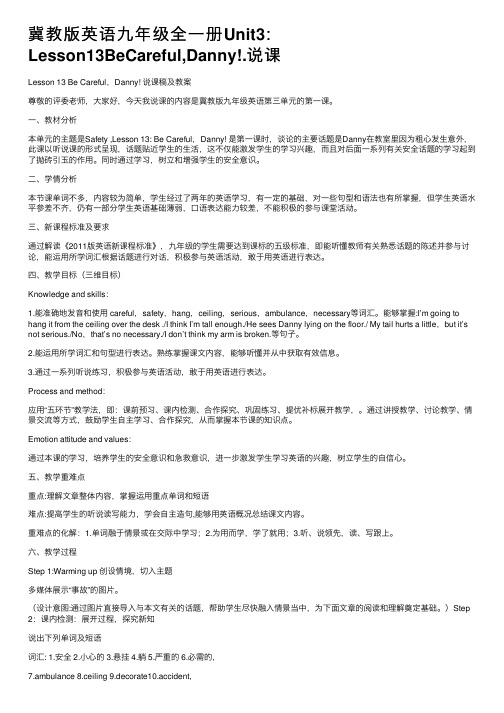
冀教版英语九年级全⼀册Unit3:Lesson13BeCareful,Danny!.说课Lesson 13 Be Careful,Danny! 说课稿及教案尊敬的评委⽼师,⼤家好,今天我说课的内容是冀教版九年级英语第三单元的第⼀课。
⼀、教材分析本单元的主题是Safety ,Lesson 13: Be Careful,Danny! 是第⼀课时,谈论的主要话题是Danny在教室⾥因为粗⼼发⽣意外,此课以听说课的形式呈现,话题贴近学⽣的⽣活,这不仅能激发学⽣的学习兴趣,⽽且对后⾯⼀系列有关安全话题的学习起到了抛砖引⽟的作⽤。
同时通过学习,树⽴和增强学⽣的安全意识。
⼆、学情分析本节课单词不多,内容较为简单,学⽣经过了两年的英语学习,有⼀定的基础,对⼀些句型和语法也有所掌握,但学⽣英语⽔平参差不齐,仍有⼀部分学⽣英语基础薄弱,⼝语表达能⼒较差,不能积极的参与课堂活动。
三、新课程标准及要求通过解读《2011版英语新课程标准》,九年级的学⽣需要达到课标的五级标准,即能听懂教师有关熟悉话题的陈述并参与讨论,能运⽤所学词汇根据话题进⾏对话,积极参与英语活动,敢于⽤英语进⾏表达。
四、教学⽬标(三维⽬标)Knowledge and skills:1.能准确地发⾳和使⽤ careful,safety,hang,ceiling,serious,ambulance,necessary等词汇。
能够掌握:I’m going to hang it from the ceiling over the desk ./I think I’m tall enough./He sees Danny lying on the floor./ My tail hurts a little,but it’s not serious./No,that’s no necessary./I don’t think my arm is broken.等句⼦。
Unit3 My Helmet Saved My Life教案冀教版英语九年级全册
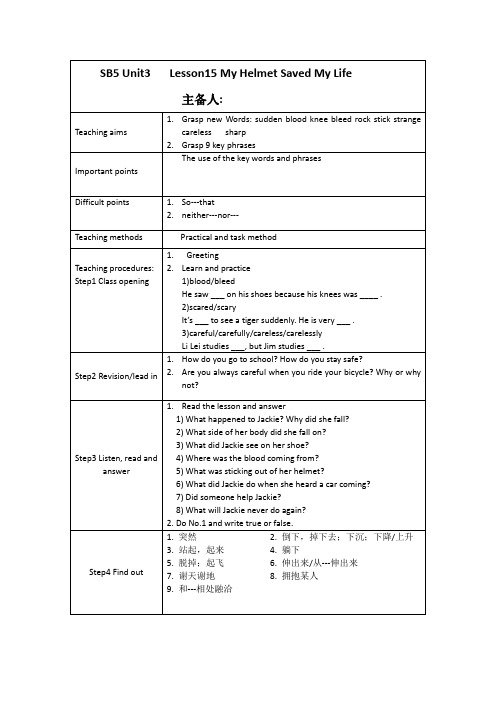
1.Read the lesson and answer
1)What happened to Jackie?Why did she fall?
2) What side of her body did she fall on?
3) What did Jackie see on her shoe?
2. Xue’an: Lesson15.
教学反思
There is nothing wrong with the machine.(同义句)
= _______________________________
2.1)The box is ___ (so/such) light that even a child can carry it.
2)This is ___ (so/such) an interesting book that all of us like it.
4) There is an old man ___ (lie) on the ground.
4. It’s scary ____ (see) the blood on his head.
5.Neither you norI ____ (be) careful.
Neither we nor Tom ____ (speak) French.
Step1 Class opening
1.Greeting
2.Learn and practice
1)blood/bleed
He saw ___ on his shoes because his knees was ____ .
2)scared/scary
冀教版九年级英语全册Unit3Lesson16教学设计

4.学生进行课堂练习,运用所学时态和词汇进行句子构建。
(三)学生小组讨论(500字)
1.教师将学生分成小组,每组选择一位成功人士进行分析,探讨其成功的原因。
2.学生运用所学词汇和句型,从品质、经历、成就等方面进行讨论,形成小组观点。
3.学生在思维品质方面,具备一定的批判性思维,但在分析、评价和创造性地表达个人观点方面还有所欠缺。
4.学生在情感态度方面,正处于青春期,对成功、榜样、人生目标等方面有着浓厚的兴趣和探索欲望,易于激发他们的学习热情和动力。
因此,在教学过程中,教师应关注学生的个体差异,充分调动他们的学习积极性,引导他们通过合作、讨论、实践等方式,提高英语综合运用能力,培养良好的思维品质和情感态度。同时,教师还需关注学生的心理发展,适时给予鼓励和支持,帮助他们树立自信,为实现自己的人生目标而努力。
- How can we achieve success?
4.词汇复习:要求学生利用课后时间,复习本节课所学的新词汇和短语,确保熟练掌握。
2.能够运用一般现在时、一般过去时和一般将来时描述人物的品质、经历和成就。
3.学会使用转折连词(however, nevertheless, on the other hand等)和因果连词(therefore, thus, as a result等)来组织篇章,使文章内容丰富、逻辑清晰。
4.能够通过阅读、听力、讨论等多种途径获取、处理和传递信息,提高英语综合运用能力。
提示:可以从以下方面进行思考:
- How does the author organize the article?
- What writing techniques does the author use?
冀教版九年级英语全册Unit3教案
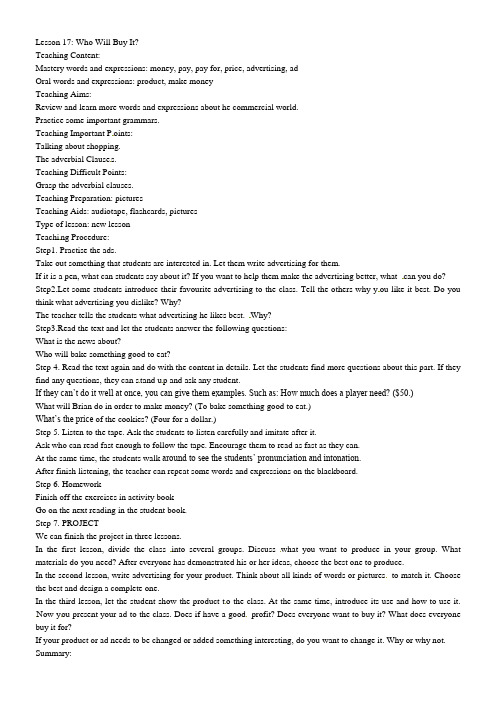
Lesson 17: Who Will Buy It?Teaching Content:Mastery words and expressions: money, pay, pay for, price, advertising, adOral words and expressions: product, make moneyTeaching Aims:Review and learn more words and expressions about he commercial world.Practice some important grammars.Teaching Important P oints:Talking about shopping.The adverbial Clause s.Teaching Difficult Points:Grasp the adverbial clauses.Teaching Preparation: picturesTeaching Aids: audiotape, flashcards, picturesType of lesson: new lessonTeachi ng Procedure:Step1. Practise the ads.Take out something that students are interested in. Let them write advertising for them.If it is a pen, what can students say about it? If you want to help them make the advertising better, what can you do? Step2.Let some students introduce their favourite advertising to the class. Tell the others why y ou like it best. Do you think what advertising you dislike? Why?The teacher tells the students what advertising he likes best. Why?Step3.Read the text and let the students answer the following questions:What is the news about?Who will bake something good to eat?Step 4. Read the text again and do with the content in details. Let the students find more questions about this part. If they find any questions, they can s tand u p and ask any student.If they can’t do it well at once, you can give them examples. Such as: How much does a player need? ($50.)What will Brian do in order to make money? (To bake something good to eat.)What’s the price of the cookies? (Four for a dollar.)Step 5. Listen to the tape. Ask the students to listen carefully and imitate after it.Ask who can read fast enough to follow the tape. Encourage them to read as fast as they can.At the same time, the students walk around to see the students’ pronunciation and intonation.After finish listening, the teacher can repeat some words and expressions on the blackboard.Step 6. HomeworkFinish off the exercises in activity bookGo on the next reading in the student book.Step 7. PROJECTWe can finish the project in three lessons.In the first lesson, divide the class into several groups. Discuss what you want to produce in your group. What materials do you need? After everyone has demonstrated his or her ideas, choose the best one to produce.In the second lesson, write advertising for your product. Think about all kinds of words or pictures to match it. Choose the best and design a complete one.In the third lesson, let the student show the product t o the class. At the same time, introduce its use and how to use it. Now you present your ad to the class. Does if have a good profit? Does everyone want to buy it? What does everyone buy it for?If your product or ad needs to be changed or added something interesting, do you want to change it. Why or why not. Summary:We are living in a new world. All around us are all kinds of ads. We can see them on TV, radios and computers. When we go to school, we can see the names of the shops which also attracts many customers in many ways. Choose the best one to present it to the class. Why do you think it is good? What do the others think about it? Leave the homework to them. Let the students to observe with their own eyes. They will find more interesting things.Lesson 18: Two Hours Too EarlyTeaching Content:Mastery words and expressions: supply, notice, quiteOral words and expressions: mall, business hoursTeaching Aims:Know more about shopping.Grasp more phrases for shopping and signs for business hours.Teaching Important Points:Some words and expressions about the business hours.Know some knowledge of shopping.Teaching Difficult Points:The adverbial clauseTeaching Preparation: picturesTeaching Aid: audiotape, flashcards, picturesType of lesson: new lessonTeaching Procedure:Ste p 1. Come to “THINK ABOUT IT”.Discuss the questions in groups, talk about the feeling that you must wait. Where must you wait? Give examples.S1: When I am ill, I must go to see a doctor. I must wait my turn.S2. When I buy my breakfast, I must wai t in queue because everyone is in a hurry. They all want to go to school or work earl ier.S3: W hen I buy something in shops I must wait.Because the shop near my home is so good that many people buy things there, I must wait.The teacher sums what the students say.:We live in a big world. We must be polite when we buy something. That’s a good manner. We can’t jump the queue. We should think more about the others.Step 2. Look at the picture of Danny. What is he doing? Do you know his feeling now?Talk about the picture in pairs. Then let some students demonstrate their ideas in front of the cl ass.Step 3. Listen to the tape and answer the following questions:When does Danny get up very early?What does the sign say?Does Danny buy the supp lies he wants?If some students can’t answer the questions well, don't lose your temper. We can go on the next step.Step 4. Read the text and c heck the answers to the listening part. Ask the students to find more questions about Danny. If they find any, they can a sk any student. If one can’t give the right answer, ot hers can help him or her.The questions can be like this:Does he take money to buy things?How long does Danny wait?Where does Danny sit?Step 5.Do with some language points.Make sentences with the following words: build, sign, hearHe wants t o build a bridge when he is older.What signs can you see near the school?I hear a baby crying loudly.Encourage them to make more sentences.Step 6. Come to “LET’S DO IT”.Divide the class into several groups. We can describe the same shop. Then let some students present their report to the class. The others try ot add the report and make it perfect.We can put up the report on the wall after class.Step 7. HomeworkFinish off the activity book.Go on the next reading in the student book.Summary:It is a good way to make sentences wit h the phrases that we learn. The more we use the phrases, the more we a re familiar with them. Then we can grasp it easily and never forget them. Give t he stu dents more time to practise in the class.Lesson 19: Know Business LingoTeaching Content:Mas tery words and expressions: success, meeting, example, fat, course, finalOral words and expressions: beginner, intermediate, advanced, au diotape, cer tificate, registration, payment, cheque, cashTeaching Aims:Know some words and expressions about the business.Learn about the foreign ads.Teaching Import ant Points:Some business lingoes.Some words and expressions.Teaching Difficult Points:How to make foreign ads?Teaching Preparation: pictur esTeaching Aids: audiotape, flashc ards, picturesType of lesson: new lessonTeaching Procedure:Step 1.Lead inIntroduce Chines e training ads to the class.If you are a teacher, you want to teach a few students in the summer holiday. What ads do you need?Bring some Chinese ads about this to the class. Let’s them try them in English. And show them to the class.Step 2. Now show the certificate of this lesson to the class. Let them guess what the program will be?Try to make ads according to the certificate. The students can make the ads in many ways. They can add different content to the ads.Work in groups and finis h the ads. They can exchange t heir ideas and make perfect ads. Then sho w it to the class.Step3.Read the text and answer the following questions:What’s business lingo?What’s the program for?Step 4. Show some new words and expressions to the class. Let them read after you if they can’t read them well by themselves. Practise them for a while. Then give them chances to practise in the class.Step 5: BrainstormBegin a brainstorm to discuss the text in details. Encourage them to ask more questions.They can ask questions like this:Do you re ally know business lingoes? Can you give examples? Where do you get them?They c an as k questions about the program. For example:If you a re a beginner, what course should you attend?How long is each course?Where are the teachers from?What languages do they speak?Step 6.Listen to the tape. Let the students imitate after it. Play the tape for several times in order to let them have exact pronunciation.The teac hers walk around the classroom to see their pronunciation. Then choose some difficulties to show them on the blackboardSt ep 7. HomeworkFinish off the activity book.Go on the next reading in the student book.Summary:Ask the students to practice with the similar things. Give them time to think what they will learn. Let them think over the words and expressions th at they’re going to learn. Practising more is good for students. This can add the students’ learning interests.Lesson 20: I’ll Buy It!Teaching C ontent:There are no mastery or oral words and expressio ns in this les son.Teaching Aims:Be more familiar to the words and expressions used in shopping.Know more about the English songs and foreign culture.Teaching Important Point s:Talking abo ut shoppingLearn to sing t he popular song.Teaching difficult Points:Talking about shoppingTeachin g Preparation: picturesTeaching Aids: audiotape, flashcards, picturesType of lesson: new less onTeaching Procedure:Step 1.Liste to the tape. Let’s sin g after it. Play the tape for several times in order to let the students grasp the rhythm of the song.Step 2. Try to sing the song together as the tape playing. Sing together twice. Then turn off the audiotape. Now a sk the students to sing loudly.Step 3. Read the song loudly as a poem. Explain some ex pressions to them if you thi nk it is necessary.Step 4. Divide the class into two groups and then practise the song again.Who sings well? Remember to give praise for a good try.Step 5. Make up a new song or dialogue with some words and expressions in the song.After the students present his or her song or dialogue to us, can the others sum the main idea? If they can’t do this, let the writer explain it to us.Step 6. Ask some volunteers to come to the front and sing.Step7.Home workFinish o ff the activity book.Go on the next reading in the student book.Summary:Some students think the English songs are hard to learn. In fact, they are easy. If you put your heart into it and don't beafraid to make mistakes, I think you will sing them well. The teacher must make good examp les for the m. They can sing i n front of the class. And the students sing after her or him. After a while, they will learn to sing and dar e t o sing in front of the class.Lesson 21: Cookies, Please!Teaching Content:Mastery words and expressions: bill, purse, an y ot her, afraid, safe, afford, coinOral words and expressions: come up to, go ove r to, That’s too much expensive. I’m afraid I can’t afford it. Teaching Aims:Learn and review some words and expressions in interesting information about real and attempted products.Talk about shopping.Teaching Important Points:The adverbial clause and articles.How to introduce your products to the customers.Teaching Difficult Points:Talk about shopping.Teaching Preparation: picturesTeaching Aid: audiotape, flashc ards, pict uresType of lesson: n ew lessonTeaching Procedure:Step e to “THINK ABOUT IT”.Talk about the questions in g roups of three or four. Then let one of the students in the group reports to the class.When the stud ents are give their reports, the others can ask questions if they like or if they have any questions.Step2.Read and answer the following questions:When are Brian and Danny selling their products?Who buy cookies from Brian?Does anybody buy Danny’s product?Step 3. Analyze the text in details.Encourage them to ask more questions about the text. Such as:W hat do you think of Danny’s product?What do you think Brian’s cookies made of?Do you want to make some cookies by yourselfStep 4.Listen to the tap e and let the students imitate after it. At the same time, they must keep silent.Step 5. Act out.Ask the students take o ut something inte resting and sell them in the class. What do they want to sel l? Who wants to buy? Do they have a deal? Observe if they have any difficulties. Help them in tim e.Write some new words on the blackboard in order to build their vocabulary.e to “LET’S DO IT”.Act out the story. If they make mistakes, don't mind them and l et them go on. They can express their ideas freely, if their grammars are correct. This is an interesting game. Encourage them to be bold and not to be nervous.Step7.HomeworkFinish off the activity book.Go on the next reading in the student book.Preview Lesson 24.Summary:Spoken English is an important part in English learn ing. Rol e-play is a good way to practise Englis h in class or out of class. Give them more chances. When they make mistakes in speaking, the teacher doesn't need to correct them immediately. Give them more time to speak. In order to increase their speaking ability, encourage them to talk abouttheir real opinions.Lesson 22: A Cookie SaleTeaching Content:Mastery words and expressions: heart, cent, deal,experienceOral words and expressions: elementary, elementary school, storybook, Junior High SchoolTeaching Aims:1. Review and learn more words and expressions about the commercial world.2. Some knowledge of shopping in fore ign countries.Teaching Important Points1. Write a passage in simple past tense.2. Talk about shopping.Teaching Difficult Shopping:The adver bial clause and object clauseTeaching Preparation: picturesTeaching Aids: audiotape, flashcards, picturesType of lesson: new lessonTeaching Procedure:Step1. Come to “THINK ABOUT IT”.Let the students work in pairs and discuss the following questions. Then report it to the class. They can express their ideas freely.S1: I don’t want to give money to those who be g s in the street. Sometimes they are very strong and they are able to support themselves. I think he’s just too lazy. He doesn’t want to work.S2: I have helped those children or old men. I think they are very poor. They don’t even have enough food to eat.S3: I give money to those who can’t go to school. I like them. I hope they all can go to school happily.The teacher can help them if necessary.Step2. Listen to the tape and answer the following questions:1. When did Brian and his classmates sell the cookies?2. What did they do with the money?Listening is a difficult part in English learning. If some students can’t find the answers, don’t worry. Let’s open our books and then r ead the text.Step3. Read the text and check the answers in listening part.Encourage the students to ask more questions. The y can ask any students to answe r. Let’s discuss the text in details. What did the cookies look like?Who helped me ma ke them?How much is one cookie cost?How much did we make?Step4. BrainstormD iscuss the following questions: If you have much money, what do you want to do? They can express their ideas freely. When the students are speaking, the teacher should lead their ideas in right directions. Let them not fall in playing and waste.Step5. Do with language pointsMake sentences with some language points: cost,deal with, It is fun…to do…How much does the book cost?How did we deal with the old clothes?It is fun to play with you.Step6. Come to “LET’S DO IT”.It is difficult for parents to work hard to support our family. Now if you are David. What would you do to sell more cookies?Let the students work in pairs and finish the work. After five minut es, ask them to give a report in the class.Step7.Homework1. Finish off the activity book.2. Go on the next reading in the student book.Summary:When students are expressing their ideas, the t eacher remembers to le ad them in right ways. Whatever we are talking about money, job, hea lth or other things, they must have normal opinions like the others. Ask them not to waste time or money on playing computers or smoking. It is important for teachers of all t he subjects to give them right life style in right ways.Lesson 23 : Push That ProductTeaching Content:Mastery words and express ions: board, rent, magazine, lady, madam, ownOr al words and expressions: Edwin Moore, push-pin, bulletin, j ourna l, employee, What’s the price of…Teaching Aims:1.Review and learn more words and expressions about the commercial world.2.Talk ab out how to make ads.Teaching Important Points:1. The adverbial clause.2. Talk about th e growing of Edwin Moore’s company.Tea ching Difficult Points:How to describe the growing of a company cl early to th e readers.Teaching Preparation: picturesTeaching Aids: audiotape, flashcards, picturesType of lesson: new lessonTeaching Procedure:[来源:Z,xx,]Step1. The teacher brings a push-pin to the class. Let the students come to know it. Do they know how to say it in English? Do they know where it is from and where is the company?Although it is small, it is a very useful invention. We can put up the pictures or posters on the wall easily. Many people in the world benefited from the little products. Do they want to know more? Let’s go on the next step.Step2. Read the text and answer the following qu estions:1. What is a push-pin used for?2. Did Moore make ads during his selling?The two questions are easy to answer. Most of the students can find the answers. They are very interesting to learn more about Moore’s company.Step3. BrainstormLet’s discuss the text further. Encourage th em to ask more questions about this part. They can ask any students any questions about the text. For example:When did Edwin Moore have an idea to product a push-pin?What was the price at that time?What was his first big succ ess?What’s the price now?If they have any difficulty, the teacher writes the new words on the blackboard and teaches them to read correctly. Step4.Listen to the tape and imitate after it. Play the tape for two t imes. Let them read after it but keep silent. Thus all the students can listen clearly and repeat after it.Let some students re ad the text in front of the class. Check their pronunciation and intonation.Step5. ProductLet the students present some other examples to the class. They can say the companies around us.They also say the famous companies in the worl d.In a student’s speech, the others can add what they know about the company. Everyone can have it’s own opinion. Encourage them to speak freely.Step6. Come to “LET’S DO IT”.If you are Moore, do you have any other ways to sell your p roducts? Encourage them to think in many ways.If you are a bo ss, what p roducts would you like to produce? Is it according to your likes and dislikes?Ask the students to give their opinions in class freely.Step 7. Homework1. Finish off t he activity book.2. Go on the next reading in the student book.Summary:Discussing is a good way to encour age students more in class. When they come across new words, the teacher has to write on the blackboard and teach them carefully. It is a good way to learn when they are interested in. Teach them how to l earn by themselves. It is important for students to have good learning habits.Lesson 24: Unit ReviewTeaching Content:Mastery words a nd expressions from Lesson 17 to Lesson 23.Oral words and expressions from Lesson 17 to Lesson 23.Teaching Aims:Review and learn new words and expressions about the world commercial.Learn more about the foreign culture.Teaching Important Points:Adverbial clause and articlesTalking about shopping.Teaching Difficult Poi nts:Let the students gra sp the ability of shopping in foreign countries.Teaching Preparation: picturesT eaching Aids: audiotape, flashcards, picturesType of lesso n: review lessonTeaching Procedure:Step 1.Play “Market Stall”.Bring something interesting to the class. Divide the class into two groups.Some students are clerks. The others are custome rs. Let’s begin our business in the class.At the same time, play the song “I’ll Buy It”.T he teacher takes part in the game a nd helps those who can’t expre ss them freely.Step2.Say something about the big companies around the world. Let the students present what they searched before class.If some others have different opinions, they can stand up and demonstrate their ideas.It is good to debate in English. That proves their spok en English is well enough.Step 3. Do with the exercises on Page 29.Ask the students to tell us the answers and why he or she chooses them. It is very important to know why.Step 4. Solve the dif ficulties on the blackboard.When they are in trouble, put the difficulties on the blackboard and let’s solve them toget her.Do more exercises about the important grammars.Step 5. Make a summary.Sum what we learn in this unit. If one studen t can’t make it perfect, t he others can add it.Step 6. Come to “Clas s Review Activity”.Play several games about this unit. Can the students themselves arrange some games by themselves? Give them chances.Step 7. HomeworkFinish off the activity boo k.Review the main lan guage points of this unit.Summary:It is importan t to sum what we learn in this unit. Speaking is one importa nt part. Doing exercises is another kind of part. Sometimes students can arrange different kind s of activities themselves. It is useful for them to create more strange ideas. The teacher should accept their ideas if they are possible do act in the class.。
Unit 3 Staying Safe in an Earthquake教案冀教版九年级英语全册
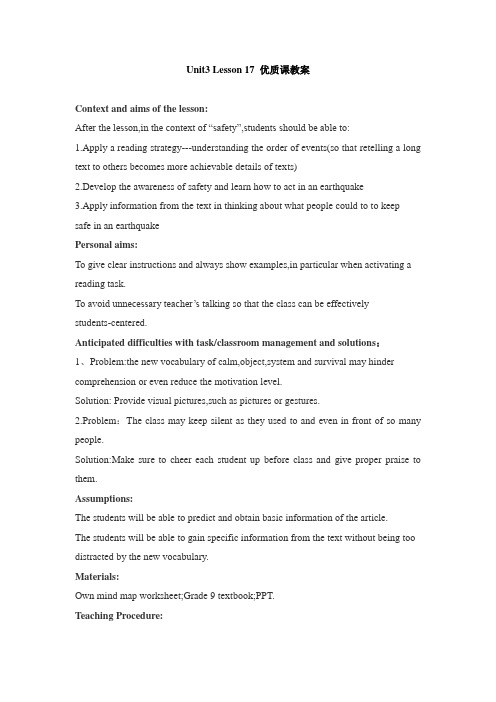
Unit3 Lesson 17 优质课教案Context and aims of the lesson:After the lesson,in the context of “safety”,students should be able to:1.Apply a reading strategy---understanding the order of events(so that retelling a long text to others becomes more achievable details of texts)2.Develop the awareness of safety and learn how to act in an earthquake3.Apply information from the text in thinking about what people could to to keep safe in an earthquakePersonal aims:To give clear instructions and always show examples,in particular when activating a reading task.To avoid unnecessary teacher’s tal king so that the class can be effectivelystudents-centered.Anticipated difficulties with task/classroom management and solutions:1、Problem:the new vocabulary of calm,object,system and survival may hinder comprehension or even reduce the motivation level.Solution: Provide visual pictures,such as pictures or gestures.2.Problem:The class may keep silent as they used to and even in front of so many people.Solution:Make sure to cheer each student up before class and give proper praise to them.Assumptions:The students will be able to predict and obtain basic information of the article.The students will be able to gain specific information from the text without being too distracted by the new vocabulary.Materials:Own mind map worksheet;Grade 9 textbook;PPT.Teaching Procedure:Step 1 Lead-in(to arouse the students’ interest and engage them in the context of earthquake)(5mins)1)Greet the students in English and make sure they can response correctly.2)Watch a video about an earthquake that happens in Wenchuan.3)Ask some students the following questions:What did you see in the video?T says many people died in this terrible earthquake.So how to keep safe when an earthquake comes?Step 2 Teaching the new lesson:(16 mins)1)Teach the new words and phrases.Make sure the students can read it correctly.2)Text:Listen to the whole text and then tells us the main idea of this text.3) Listen to the whole text again and answer some questions.4 )Read the text loudly and say the topic of each paragraph.Step 3 Think about the acts to keep safe in an earthquake(5 mins)Read the text silently and fill in the mind maps on your paper.Step 4 Make sure that everyone would be clear about the ways about safety in an earthquake.(5 mins)Check answers and read it together.Step 5 Group work(6 mins)Please talk about what we should do to help people in an earthquake.Step 6 Show your group’s ideas.(7mins)Students’ presentations.Step 7. Homework.(1 min)Write a short passage about what you should do when and after an earthquake happens.教学反思:本课以素质教育为目的,结合教材重点、难点及英语学科特点,利用任务型教学,从听、说、读、写等方面使学生得到锻炼。
冀教版英语九年级全一册Unit3:Lesson13BeCareful,Danny!优秀教学案例
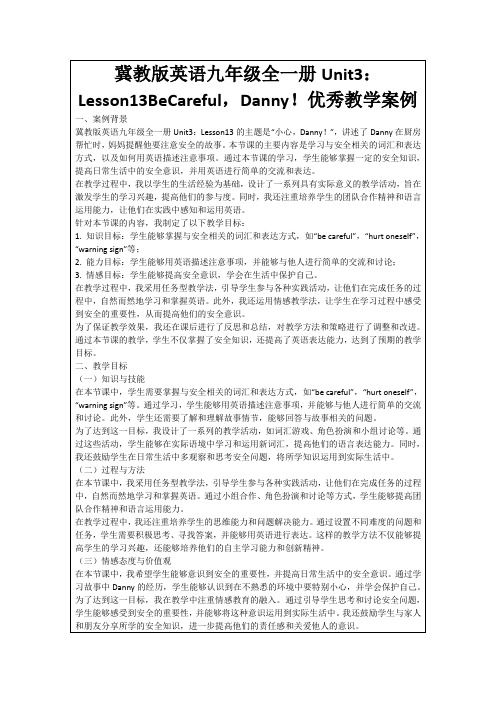
一、案例背景
冀教版英语九年级全一册Unit3:Lesson13的主题是“小心,Danny!”,讲述了Danny在厨房帮忙时,妈妈提醒他要注意安全的故事。本节课的主要内容是学习与安全相关的词汇和表达方式,以及如何用英语描述注意事项。通过本节课的学习,学生能够掌握一定的安全知识,提高日常生活中的安全意识,并用英语进行简单的交流和表达。
为了达到这一目标,我在教学中注重情感教育的融入。通过引导学生思考和讨论安全问题,学生能够感受到安全的重要性,并能够将这种意识运用到实际生活中。我还鼓励学生与家人和朋友分享所学的安全知识,进一步提高他们的责任感和关爱他人的意识。
三、教学策略
(一)情景创设
为了激发学生的学习兴趣和参与度,我精心设计了各种情景,让学生在真实的语境中学习和运用英语。例如,在教授安全词汇时,我模拟了一个厨房场景,让学生扮演Danny和妈妈,通过角色扮演的方式,学习和运用新词汇。这样的情景创设不仅能够使学生身临其境,还能够提高他们的学习积极性。
为了保证教学效果,我还在课后进行了反思和总结,对教学方法和策略进行了调整和改进。通过本节课的教学,学生不仅掌握了安全知识,还提高了英语表达能力,达节课中,学生需要掌握与安全相关的词汇和表达方式,如“be careful”,“hurt oneself”,“warning sign”等。通过学习,学生能够用英语描述注意事项,并能够与他人进行简单的交流和讨论。此外,学生还需要了解和理解故事情节,能够回答与故事相关的问题。
4.多样化的教学活动:本节课设计了一系列具有实际意义的教学活动,如词汇游戏、角色扮演和小组讨论等。这些活动不仅能够激发学生的学习兴趣,还能够培养他们的思维能力和问题解决能力。
冀教版英语九年级全一册Unit3Lesson15MyHelmetSavedMylife.教学设计

1.教师呈现教材中的对话,引导学生关注一般过去时态的运用,并解释其意义和用法。
2.通过实物、图片和示例,教授与本课相关的词汇,如"helmet"、"accident"、"consequence"等,让学生在实际语境中理解和记忆。
3.分析教材中的句子结构,如"I was doing...when...","If I hadn't...I would have...",引导学生运用一般过去时态描述过去发生的事情。
作业布置要求:
1.作业内容要结合课本知识,注重实践性和趣味性,提高学生的学习兴趣。
2.学生在完成作业时,注意语言表达的准确性和语法正确性。
3.家长要关注学生的学习进度,协助学生完成作业,并给予适当的指导和建议。
4.教师在批改作业时,要及时发现问题,给予反馈,帮助学生不断提高。
(一)教学重难点
1.词汇与语法:本章节的重点在于交通安全相关词汇的掌握和一般过去时态的运用。学生在实际语境中运用这些词汇和语法结构进行表达是学习的难点。
-教学设想:通过多媒体展示、角色扮演和情景模拟等活动,帮助学生将词汇和语法点与实际情境相结合,提高语言运用的准确性。
2.听力理解:学生需要在听力活动中理解并获取关键信息,这对他们的听力理解能力提出了挑战。
4.听力:学生能够听懂并理解与本课相关的对话和故事,提高对英语听力的理解和反应能力。
5.口语:学生能够在小组讨论中,运用所学知识分享自己的经历,提高口语表达能力。
6.写作:学生能够撰写一篇关于交通安全的故事或日记,运用一般过去时态和所学词汇。
(二)过程与方法
在本章节的教学过程中,教师将采用以下方法帮助学生达成目标:
冀教版英语九年级全一册Unit3:Lesson13BeCareful,Danny!教学设计
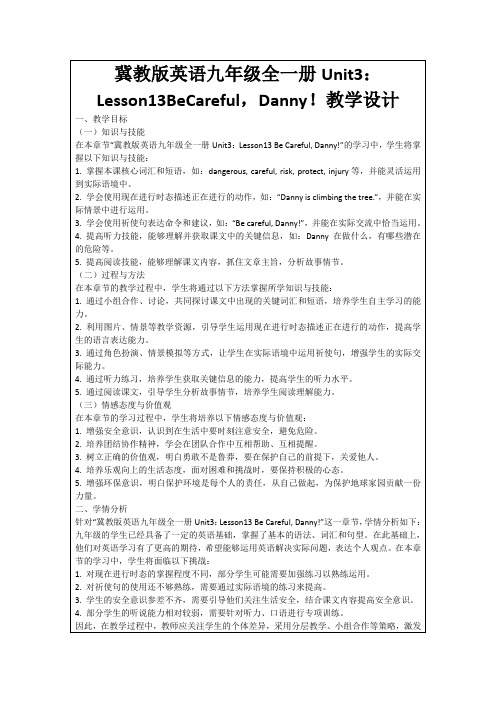
1.教学活动:将学生分成小组,每组讨论以下问题:“What dangerous things might happen while playing outside? How can we protect ourselves?”。
2.讨论要求:学生用英语进行讨论,并记录下小组成员的观点和建议。
四、教学内容与过程
(一)导入新课
1.教学活动:教师展示一张描绘户外活动的图片,如孩子们在公园玩耍、骑自行车、滑滑板等,引导学生观察并思考安全问题。
2.提问环节:教师提问:“What are the children doing? Do you think they are being safe?”,让学生用英语回答,激发学生对安全话题的兴趣。
三、教学重难点和教学设想
(一)教学重难点
1.重难点一:现在进行时态的运用
学生在理解现在进行时态的概念后,需要能够在实际语境中灵活运用,这是本章的一个重点和难点。为了突破这一难点,教师需要设计多样化的练习活动,如角色扮演、情景模拟等,让学生在实际交流中掌握现在进行时态。
2.重难点二:祈使句的运用
祈使句在日常交流中非常常见,但学生在实际使用时往往不够自信。教师需要通过丰富的教学活动,如命令游戏、角色扮演等,帮助学生熟练掌握祈使句的结构和用法。
3.重难点三:词汇和短语的掌握
词汇和短语是英语学习的基石,本章节的词汇和短语如“dangerous”, “careful”, “protect”等,需要学生在理解的基础上,能够熟练运用到句子和语境中。
(二)教学设想
1.设想一:情境教学法
教学中将采用情境教学法,通过创设与课文相关的真实情境,让学生在情境中感知、体验和运用目标语言。例如,模拟Danny爬树的场景,让学生使用现在进行时态进行描述,并运用祈使句给出建议。
冀教版英语九年级全册Unit3Lesson14教学设计
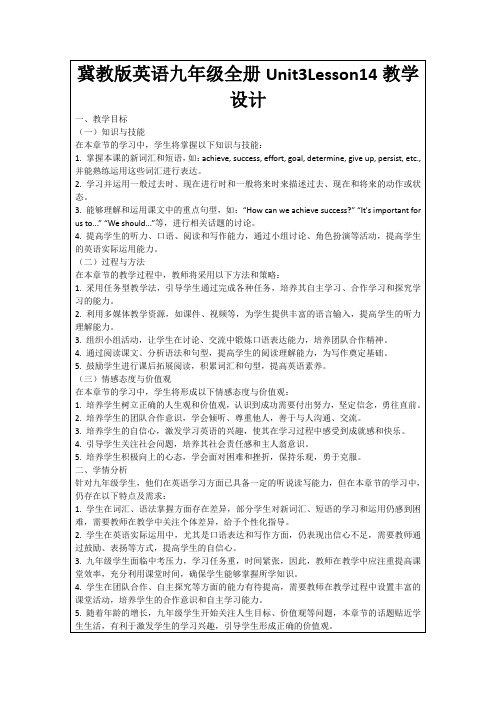
2.教学活动设计:
a.教师引导学生回顾本节课所学内容,总结词汇、短语、句型的重点和难点。
b.学生分享自己在课堂中的收获,以及对成功、努力等价值观的认识。
c.教师总结课堂教学,强调学习英语的重要性,鼓励学生在今后的学习中不断努力,实现自己的人生目标。
五、作业布置
为了巩固本节课所学知识,提高学生的英语综合运用能力,特布置以下作业:
1.词汇、短语练习:请学生完成课后练习册中与本节课相关的词汇、短语练习,加强记忆和运用。
2.句型和时态练习:结合本节课所学句型和时态,编写一段小对话,描述一个成功人士的故事。要求运用一般过去时、现在进行时和一般将来时,不少于50词。
4.学生在团队合作、自主探究等方面的能力有待提高,需要教师在教学过程中设置丰富的课堂活动,培养学生的合作意识和自主学习能力。
5.随着年龄的增长,九年级学生开始关注人生目标、价值观等问题,本章节的话题贴近学生生活,有利于激发学生的学习兴趣,引导学生形成正确的价值观。
三、教学重难点和教学设想
(一)教学重难点
3.重点:引导学生树立正确的人生观和价值观。
难点:如何将情感态度与价值观的培养融入到教学过程中,使学生能够自然地接受并内化为自身的观念。
(二)教学设想
1.针对词汇、短语和句型的教学,可采用以下设想:
a.利用图片、实物等直观教具,帮助学生形象记忆新词汇和短语。
b.创设真实的语境,让学生在实际交流中运用所学的句型和时态,提高学生的语言表达能力。
c.设计各种形式的练习,如填空、选择、改错等,巩固学生对词汇、短语和句型的掌握。
2.针对培养学生的听力、口语、阅读和写作能力,可采用以下设想:
冀教版九年级英语全一册 Unit 3 单元 教案

冀教版九年级英语全一册Unit 3 单元教案Lesson 13: Be Careful, Danny!I. Learning aims:Master the new words:careful, safety, hang, ceiling, serious, ambulance, necessaryII. Learning important and difficult points:1) I think I’m tall enough.2) I tried to catch you, but you landed on top of me.3) I don’t think my arm is broken.4) Tell her we are taking Brian to the hospital.Language Points:1. careful【用法】作形容词,意为“小心的、仔细的”,在句中作定语或表语。
它的副词形式是carefully。
【举例】①Li Hong is a careful girl. She does everything carefully.李红是个认真的女孩。
她做任何事情都很认真。
②Please be careful when you cross the street. 当您横过街道时要当心。
2. I tried to catch you, but you landed on top of me. 我尽力要抓住你,但你落在了我头上。
【用法】句式try to do something 意为“尽力做某事”;类似句式try doing something 则表示“尝试做某事”。
【举例】①I’ll try to do everything well. 我将尽力做好每件事情。
②Li Ming is trying to skate on the real ice. 李明正在尝试着在真正的冰上滑冰呢。
冀教版九年级英语全册教学设计Unit 3 Lesson 16教案
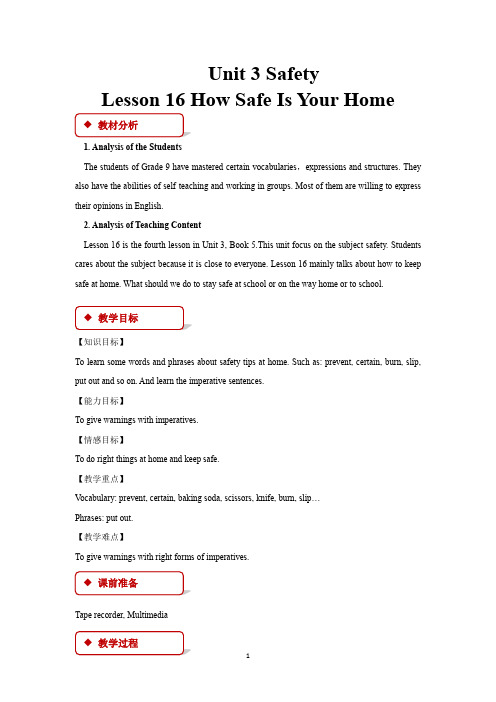
Unit 3 SafetyLesson 16 How Safe Is Your Home1. Analysis of the StudentsThe students of Grade 9 have mastered certain vocabularies,expressions and structures. They also have the abilities of self-teaching and working in groups. Most of them are willing to express their opinions in English.2. Analysis of Teaching ContentLesson 16 is the fourth lesson in Unit 3, Book 5.This unit focus on the subject safety. Students cares about the subject because it is close to everyone. Lesson 16 mainly talks about how to keep safe at home. What should we do to stay safe at school or on the way home or to school.【知识目标】To learn some words and phrases about safety tips at home. Such as: prevent, certain, burn, slip, put out and so on. And learn the imperative sentences.【能力目标】To give warnings with imperatives.【情感目标】To do right things at home and keep safe.【教学重点】V ocabulary: prevent, certain, baking soda, scissors, knife, burn, slip…Phrases: put out.【教学难点】To give warnings with right forms of imperatives.Tape recorder, MultimediaStep 1. Warm-upThink: Is your home a safe place? Why or why not?Let the students watch a video which is about a kitchen that is on fire.Step 2. Presentation1. Listen to Part I and tell true (T) or false (F)(1)Sometimes home is not safe enough. ( )(2)Kitchen and living room are the two most dangerous rooms in the house. ( )(3)People can prevent certain accidents. ( )2. Check the answers.3. Read the text and answer the following questions.(1)Why are the kitchen and the bathroom the two most dangerous rooms in the house?(2)What are the safety tips to prevent accidents in the kitchen?(3)What are the safety tips to prevent accidents in the bathroom?(4)Why shouldn’t parents leave young children alone in the bathtub?4.Check the answers.5.Explain the language points:Can people prevent certain accidents?prevent为及物动词,意为“阻止,预防”,常用结构prevent sb. from doing sth.意为“阻止某人做某事”,与stop sb. from doing sth.用法相同。
- 1、下载文档前请自行甄别文档内容的完整性,平台不提供额外的编辑、内容补充、找答案等附加服务。
- 2、"仅部分预览"的文档,不可在线预览部分如存在完整性等问题,可反馈申请退款(可完整预览的文档不适用该条件!)。
- 3、如文档侵犯您的权益,请联系客服反馈,我们会尽快为您处理(人工客服工作时间:9:00-18:30)。
冀教版九年级英语全一册Unit 3 单元教案Lesson 13: Be Careful, Danny!I. Learning aims:Master the new words:careful, safety, hang, ceiling, serious, ambulance, necessaryII. Learning important and difficult points:1) I think I’m tall enough.2) I tried to catch you, but you landed on top of me.3) I don’t think my arm is broken.4) Tell her we are taking Brian to the hospital.Language Points:1. careful【用法】作形容词,意为“小心的、仔细的”,在句中作定语或表语。
它的副词形式是carefully。
【举例】①Li Hong is a careful girl. She does everything carefully. 李红是个认真的女孩。
她做任何事情都很认真。
②Please be careful when you cross the street. 当您横过街道时要当心。
2. I tried to catch you, but you landed on top of me. 我尽力要抓住你,但你落在了我头上。
【用法】句式try to do something 意为“尽力做某事”;类似句式try doing something 则表示“尝试做某事”。
【举例】①I’ll try to do everything wel l. 我将尽力做好每件事情。
②Li Ming is trying to skate on the real ice. 李明正在尝试着在真正的冰上滑冰呢。
3. I don’t think my arm is broken. 我认为我的胳膊没有折。
【用法】在动词think, believe, expect, guess等后面的宾语从句中的谓语动词如果是否定形式,这一否定形式往往转移到主句中,也就是主句成了否定形式,而从句成了肯定形式,但实际上还是否定的从句。
【举例】We don’t believe the y can keep up with us. 我相信他们是不会赶上我们的。
Lesson 14: Accidents HappenI. Learning aims:Master the new words:accident, town, Alberta, James, reporter, roll, Andrews, fault, icy, ugly, shoulder, wound, recover, expectII. Learning important and difficult points:1) “We were in a hurry,” James told the reporter.2)I wanted to stop her from running after the ball, but she didn’t hear me.3)He stopped traffic on the road until the ambulance came.4) Doctors can expect to return to school in about a week.Language Points:1. wound【用法】作可数名词,意为“伤口、伤害”,后加名词或代词作宾语。
【举例】Your wound is slightly infected. 你的伤口有点儿感染了。
【用法】wounded 表示“受伤的”,the wounded 表示“伤员”,是集体名词。
【举例】The doctor is trying to save the wounded soldiers. 医生正在抢救受伤的战士。
2. “We were in a hurry,” James told th e reporter.【用法】in a hurry意为“匆忙、着急”,可用在系词后作表语,也可用在动词后作状语。
【举例】①Why are you in a hurry, Li Ming? 你为什么这么着急,李明?②Danny went to school in a hurry just now. 刚才丹尼匆匆忙忙地上学去了。
3. I wanted to stop her from running after the ball, but she didn’t hear me. 我想要阻止她不要在球后面跑了,但她不听我的。
【用法】句式stop…from doing…意为“阻止……做某事”,其中的stop可用keep, prevent加以替换。
【举例】The heavy rain stopped us from having sports meeting. 大雨阻止了我们举行运动会。
Lesson 15: My Helmet Saved My Life!I. Learning aims:Master the new words:helmet, wham, blood, knee, bleed, sharp, stick, scary, goodness, stranger, carelessII. Learning important and difficult points:1) “There is something wrong with me,” I thought.2) I felt so terrible that I lay down again.3) It was pretty scary to look at.4) She knew I was careless and not always wear my helmet.Language Points:1. blood【用法】作不可数名词,意为“血、血液、血统”。
【举例】There is 83% of water in the blood. 血液中83%的成分是水。
2. stick【用法】作可数名词,意为“棍棒、枝条”。
【举例】You can tie the young tree to the stick. 你可以把小树绑在木棍上。
【用法】作及物动词,意为“粘贴、穿入、坚持”,后加名词、代词、不定式作宾语。
【举例】①Mr. Zhang stuck a map on the wall. 张先生在墙上粘了一张地图。
②They stick to learn another language. 他们坚持学习另一门语言。
3. “There is something wrong with me,” I thought. “我有些麻烦”,我想。
【用法】由some, any ,no, every 加上thing, body, one可以构成表示人或物的不定代词。
比如something, anything, nothing, everything, somebody, anybody, nobody, everything等。
以这类代词作主语时,谓语动词要用单数形式;并且形容词修饰这类不定代词时应该放在这些不定代词之后。
【举例】①Everything is OK. L et’s begin our meeting.一切都准备好了。
咱们开会吧。
②Is there anything new in today’s newspaper?今天的报纸上有什么新消息吗?Lesson 16: How Safe Is Your Home?I. Learning aims:Master the new words:prevent, themselves, slip, baking, soda, salt, knife, poison, heat, burn, bathtubII. Learning important and difficult points:1) Many people hurt themselves by falling off chairs.2) Don’t use water to put out kitchen fires.3) Never use electricity in the shower or bathtub.4) It’s easy to slip and fall on a wet floor.Language Points:1. heat【用法】作不可数名词,意为“热、热度”。
【举例】The sun gives us light and heat. 太阳给了我们光和热。
【用法】作及物动词,意为“使……温暖、加热”。
【举例】Danny heated the water just now and it is hot now. 丹尼刚才把水加热了,现在水热了。
2. Many people hurt themselves by falling off chairs. 很多人由于从椅子上落下来而伤到自己。
【用法】句式by 加动名词或动名词短语,意为“通过……、由于……”,在句中作状语,表示原因或方式。
【举例】Lisa learns English by listening and speaking. 丽萨通过听和说学英语。
3. It’s easy to slip and fall on a wet floor. 在潮湿的地板上很容易滑倒和摔跤。
【用法】不定式作主语时,往往用it作形式主语,而将不定式放在后面。
这句话中的主语是to slip and fall on a wet floor, it是形式主语,is是系词,easy是表语。
【举例】①To hear your voice is so nice. = It is nice to hear your voice. 听到你的声音真高兴。
②To learn English well is very important. = It is very important to learn English well. 学好英语很重要。
【举例】It is too late. Please stop playing games. 时间很晚了。
请不要玩游戏了。
Lesson 17: Staying Safe in an EarthquakeI. Learning aims:Master the new words:earthquake, calm, object, system, survivalII. Learning important and difficult points:1) What should you do it this happens to you?2) You need to have something strong around you to protect you from falling objects.3) Keep an eye out of things that can fall on you.4) Staying calm is not easy, but it can save your life.Language Points:1. What should you do it this happens to you? 如果这发生在你身上你应该怎么办?【用法】句式happen to somebody (something) 表示“某人(物)出……事或发生情况。
